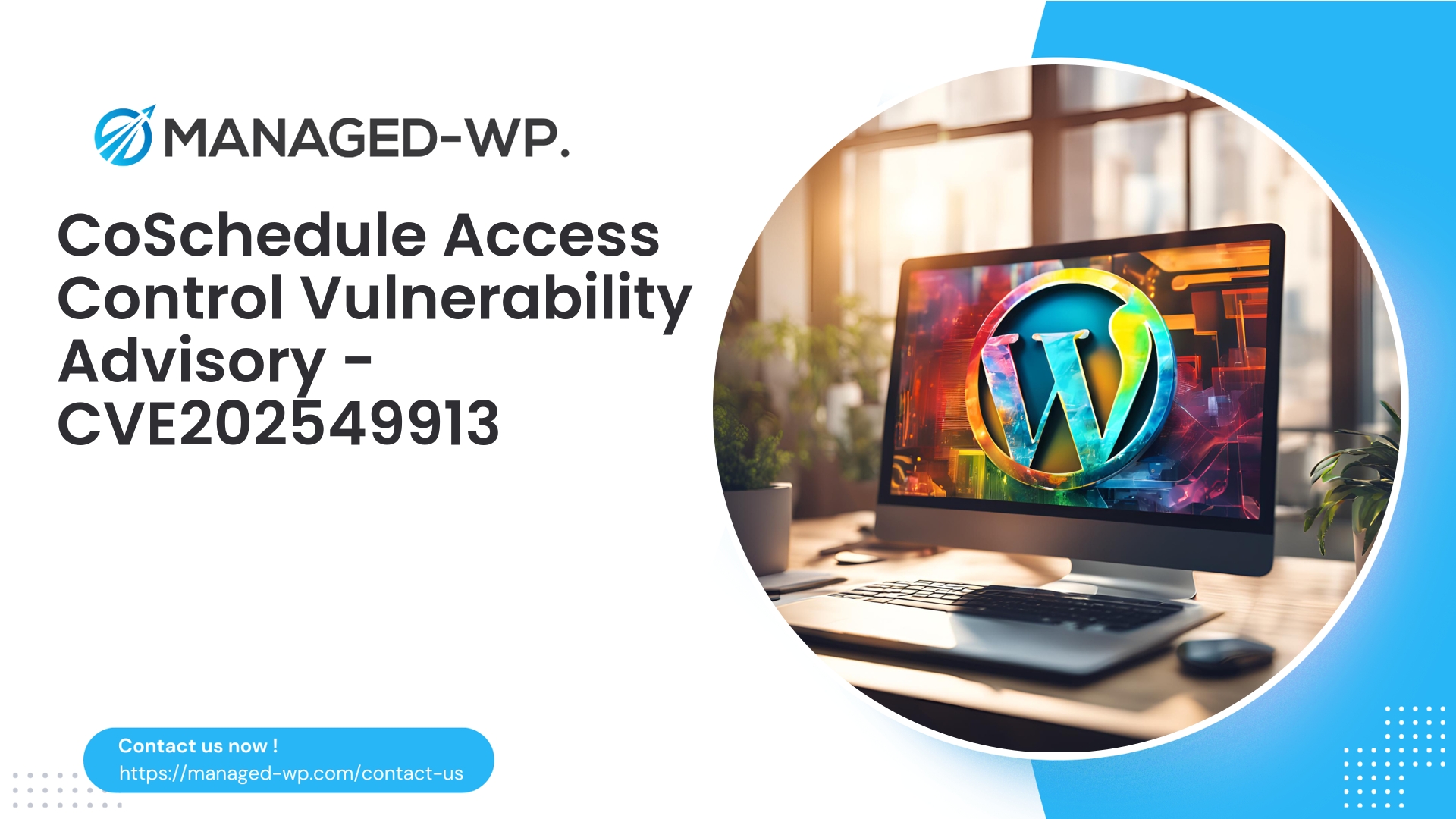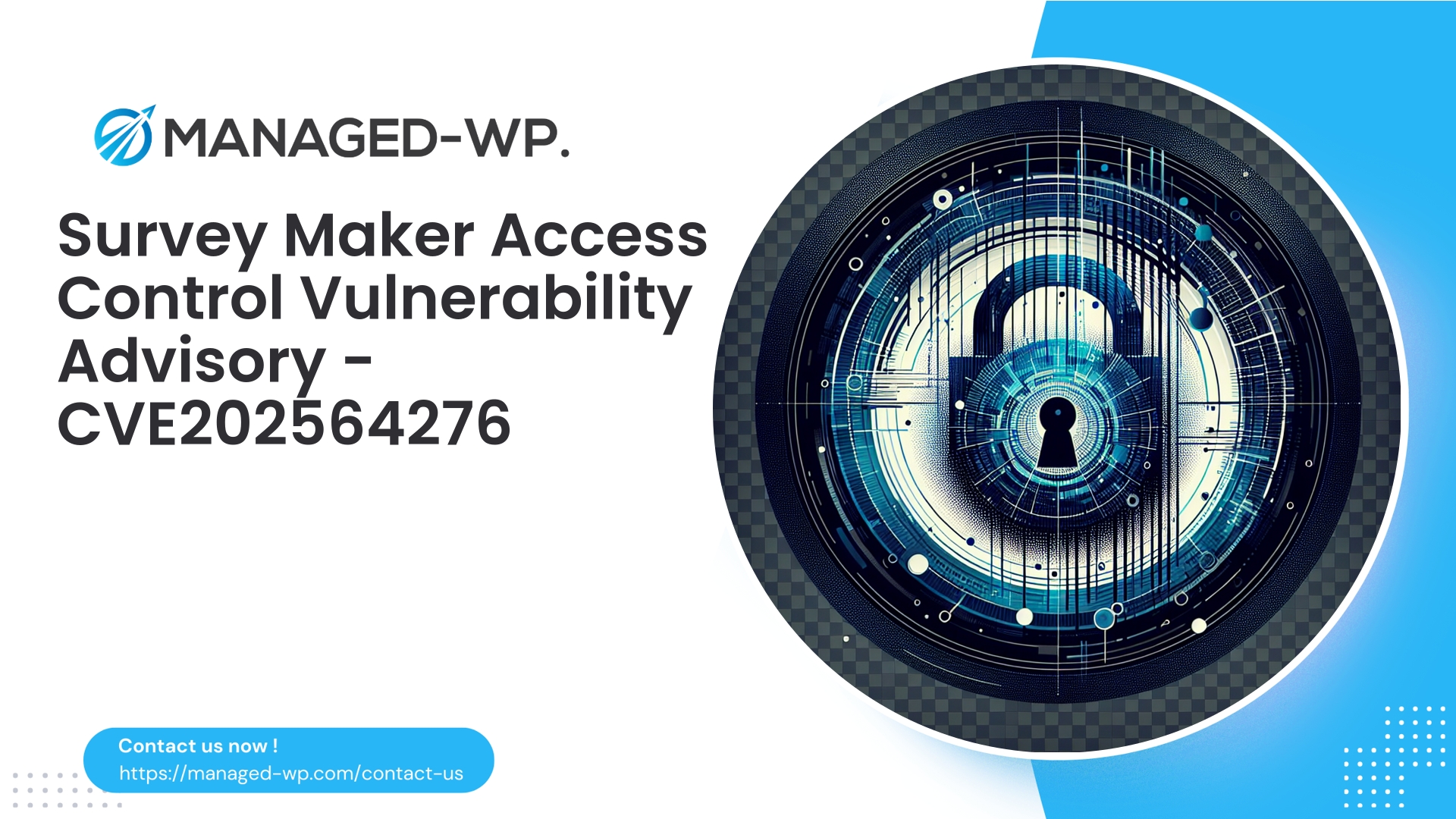| 插件名稱 | 協同計劃 |
|---|---|
| 漏洞類型 | 存取控制繞過 |
| CVE編號 | CVE-2025-49913 |
| 緊急 | 低的 |
| CVE 發布日期 | 2025-11-16 |
| 來源網址 | CVE-2025-49913 |
緊急:針對 WordPress 網站所有者的重要公告:CoSchedule 外掛程式存在存取控制漏洞 (CVE-2025-49913)
執行摘要
安全研究人員已公開披露CoSchedule WordPress外掛程式中存在一個“存取控制漏洞”,該漏洞影響3.4.0及之前的所有版本(CVE-2025-49913)。此漏洞允許未經身份驗證的攻擊者呼叫插件的特權函數,可能導致未經授權的操作。供應商已在3.4.1版本中修復了此漏洞。儘管通用漏洞評分系統(CVSS)將此問題的嚴重程度評為中低(5.3),但其實際風險——尤其對於高知名度或目標明確的WordPress網站而言——仍然不容忽視。如果您的網站使用了此插件,建議立即更新或採取緩解措施。.
這份由 Managed-WP 安全團隊編寫的簡報,將技術細節轉化為可操作的情報。它包括清晰的檢測方法、緩解策略,以及可立即部署以降低風險的 Web 應用防火牆 (WAF) 規則的參考資訊。.
關鍵細節
- 漏洞: 存取控制失效(未經身份驗證)
- 受影響版本: CoSchedule ≤ 3.4.0
- 已修補: 版本 3.4.1
- CVE標識符: CVE-2025-49913
- CVSS評分: 5.3(中/低)
- 披露日期: 2025年11月16日
- 攻擊向量: 未經驗證的 HTTP 請求,指向外掛程式 REST、AJAX 或自訂端點
了解 WordPress 環境中的存取控制缺陷
存取控制漏洞是指應用程式未能充分限制使用者存取不應存取的功能。尤其是在 WordPress 外掛程式中,當 REST API 路由、AJAX 處理程序或自訂端點的驗證或權限檢查未正確執行時,就會出現這種情況。.
可能導致此漏洞的常見設定錯誤包括:
- REST API 路由沒有嚴格的限制
權限回調處理程序。 - 管理員 Ajax 或操作鉤子執行關鍵操作,而沒有進行能力檢查或 nonce 驗證。.
- 接受參數的公共端點,這些參數會觸發特權操作,而無需驗證呼叫者的身分。.
在這種情況下,CoSchedule 外掛程式允許未經身份驗證的使用者發起通常保留給授權角色的操作,包括建立或修改內容或外掛程式設定。.
潛在攻擊場景
請看以下攻擊者可能利用此漏洞進行的實際操作範例:
- 意外觸發已安排的貼文和社群媒體任務的發布或修改。.
- 更改外掛程式配置,例如 webhook 或 API 金鑰,可能會將內容或資料重定向到其他地方。.
- 建立持久性計畫任務或定時事件,以維持未經授權的存取或操作。.
- 將此漏洞與其他漏洞串聯起來,可以提升權限或安裝後門。.
鑑於 CoSchedule 在編輯和社交媒體日程安排工作流程中的作用,快速修復至關重要。.
如何判斷您的網站是否有漏洞
- 請驗證插件版本:
- 在 WordPress 管理後台:導覽至“外掛程式”>“已安裝外掛程式”,找到 CoSchedule 版本。.
- 或檢查主插件 PHP 檔案中的插件版本,該檔案通常位於
wp-content/plugins/coschedule/.
- 3.4.0 及更早版本均有漏洞。.
- 檢查您的 Web 伺服器和 WordPress 日誌,尋找針對以下目標的可疑未經驗證的請求:
admin-ajax.php與 CoSchedule 相關的操作參數協同行程,cosch_前綴)。.- 包含的 REST API 呼叫
/wp-json/coschedule/或類似的命名空間。 - 來自單一 IP 位址或不常見使用者代理程式的異常活動峰值。.
- 注意以下跡象:
- 意外發布或編輯的貼文。.
- 新增定時任務。.
- 更改了外掛選項(API 金鑰、webhook URL)。.
- 未經授權的使用者角色或帳戶變更。.
- 進行徹底的惡意軟體掃描和檔案完整性檢查。.
網站所有者應立即採取的行動
請依照以下優先步驟減少接觸風險:
- CoSchedule 更新至 3.4.1 版本: 立即套用官方安全補丁。如有條件,請在測試環境中進行測試。.
- 如果您現在無法更新:
- 暫時停用 CoSchedule 插件。.
- 透過防火牆或伺服器規則對外掛端點實施存取限制。.
- 加強管理權限:
- 限制
/wp-admin和/wp-login.php盡可能透過 IP 白名單或 HTTP 基本驗證進行存取。. - 為所有管理員使用者啟用雙重認證(2FA)。.
- 限制
- 部署虛擬修補程式:
- 應用 WAF 規則,阻止對 CoSchedule 插件 REST 和 AJAX 端點的未經身份驗證的請求(示例如下)。.
- 加強監測:
- 定期檢查訪問日誌,發現可疑請求。.
- 定期運行惡意軟體和完整性掃描。.
- 如果懷疑有妥協:
- 啟用維護模式,隔離該網站。.
- 從入侵前建立的經過驗證的備份進行還原。.
- 重置所有管理員密碼、API金鑰和金鑰。.
- 進行全面的取證分析,或聘請專業的事故應變團隊。.
虛擬修補程式和防火牆規則範例
部署這些範例規則,保護您的網站免受已知攻擊途徑的侵害。請根據您的託管環境進行自訂。.
Nginx 範例規則
如果請求方法為 POST,則在伺服器 {} 或位置 / {} 內新增 # { 設定 $block_coschedule 為 0;如果要求 URI 為 /wp-admin/admin-ajax.php,則如果 http_cookie 不為 wordpress_logged_in_,則如果參數為參數為參數為(^|&)action=(coschedule|cosch_[a-z0-9_]*)(&|$),則設定 $block_coschedule 為 1;若 block_coschedule 為 1,則傳回 403。
注意:如果您的網站依賴未經身份驗證的 AJAX 前端調用,請評估是否有誤報。.
Apache mod_security 範例
SecRule REQUEST_URI "@contains /wp-admin/admin-ajax.php" "phase:2,chain,deny,status:403,msg:'阻止未經身份驗證的 CoSchedule AJAX 操作'" SecRule ARGS_NAMES|ARGS "@rx^pactionT14T5p" ^(coschedule|cosch_)" "chain" SecRule REQUEST_HEADERS:Cookie "!@rx wordpress_logged_in_" "id:1009001,severity:2""
WordPress PHP mu-plugin 虛擬補丁
403 ) ); } } } });
在外掛程式更新可以安全應用之前,此程式碼片段可作為短期緩解措施。.
開發者和插件維護者的指南
若要修復此類存取控制漏洞,請遵循以下安全編碼實務:
- REST API 路由: 始終嚴格執行
權限回調驗證用戶能力。.register_rest_route( 'my-plugin/v1', '/sensitive-action', array( 'methods' => 'POST', 'callback' => 'my_plugin_sensitive_action_handler', 'permission_callback' => function ( 1TP4dvunction); ) ); - 管理員 AJAX 處理程序: 使用
檢查 Ajax 引用者()以及用於驗證請求的功能檢查。.add_action( 'wp_ajax_my_sensitive_action', 'my_sensitive_action_handler' ); function my_sensitive_action_handler() { check_ajax_referer( 'my_action_nonce', 'nonce' ); if ( 'Unauthorized', 403 ); } // 執行已授權的操作 } - 公共端點: 限制公共端點僅支援安全的唯讀操作。避免特權寫入。.
- 預設拒絕: 如有疑問,拒絕訪問。明確且謹慎地授予權限。.
- 輸入驗證: 對所有傳入資料進行嚴格的清理和驗證。.
- 記錄: 對特權端點存取嘗試實作詳細日誌記錄。.
- 測試: 加入單元測試和整合測試,以驗證未經授權的請求是否已封鎖。.
驗證您的緩解措施
- 在測試環境中透過複製類似於已知漏洞的請求進行測試(在沒有適當安全措施的情況下,絕對不要在生產環境中進行測試)。.
- 使用類似工具
捲曲或使用 Postman 發送未經授權的請求並驗證 403 或 401 回應。. - 使用 curl 進行範例測試:
curl -i -X POST "https://yourdomain.com/wp-admin/admin-ajax.php" -d "action=coschedule_test_action¶m=value""
- 測試後檢查日誌,確認沒有執行任何敏感操作。.
入侵指標 (IoC)
密切注意漏洞是否已被利用的跡象:
- 意外發布或編輯的貼文以及相關的元資料修改。.
- 已新增或已變更與外掛程式關聯的 WP Cron 定時任務。.
- 無法解釋的出站連線或指向未知目的地的 webhook。.
- 建立新使用者帳戶或提升權限。.
- 來自陌生 IP 位址的可疑存取日誌條目,目標是插件端點。.
- 插件資料夾中的檔案已被修改,且時間戳可疑。.
如果你發現妥協的跡象:
- 保留所有日誌和系統快照,以便取證分析。.
- 從事件發生前的安全備份中復原。.
- 輪換所有敏感憑證和API金鑰。
- 進行全面的惡意軟體和系統掃描。.
了解為何 CVSS 5.3 可能低估實際風險
CVSS評分是技術嚴重性指標,它並不能完全反映組織或營運方面的影響。請考慮以下幾點:
- 該插件與外部服務的整合意味著 API 金鑰或 Webhook 可能被利用來擴大資料外洩範圍。.
- 流量高或品牌知名度高的網站更容易成為攻擊目標。.
- 攻擊者可能會將此漏洞與其他漏洞結合起來,以提升權限或完全控制系統。.
務必將此類漏洞視為緊急營運風險,並優先考慮縱深防禦策略。.
營運最佳實踐
- 保持規範的更新工作流程:在生產部署之前,利用暫存和測試環境。.
- 定期建立並驗證異地備份。.
- 限制插件的安裝和更新權限,僅限受信任的管理員群組。.
- 對 WordPress 核心、外掛程式和主題啟用持續監控和檔案完整性檢查。.
- 強制執行基於角色的存取控制和最小權限原則,特別是對於 API 金鑰和憑證。.
- 強制所有特權使用者啟用雙重認證,並執行嚴格的密碼原則。.
- 利用虛擬修補程式和WAF解決方案,在漏洞出現時快速緩解風險。.
託管式 WordPress 防火牆的作用
在漏洞揭露期間,漏洞公告發佈與供應商修補程式在所有 WordPress 網站上全面部署之間存在一個關鍵的時間間隔。託管式 WordPress 防火牆透過以下方式彌補了這一時間間隔:
- 在惡意請求模式到達易受攻擊的插件程式碼之前,偵測並封鎖它們。.
- 應用虛擬修補程式來修復新揭露的漏洞,而無需修改網站檔案。.
- 提供持續監控和警報,以降低風險敞口。.
- 允許網站所有者在以受控方式應用更新的同時保持網站可用性。.
對於無法立即更新 CoSchedule 或需要分階段採取安全措施的站點,虛擬修補是一種有效的臨時控制措施。.
Managed-WP 基礎保護計畫 — 立即開始
立即獲得免費託管保護
考慮到修補程式部署可能需要時間,Managed-WP 提供免費的基礎套餐,其中包括必要的安全控制措施:託管式 WAF、惡意軟體掃描、OWASP Top 10 防護以及無限頻寬。我們的安全專家會配置規則並監控威脅,以確保您的 WordPress 網站在類似事件中更安全。點擊此處註冊,即可獲得免費保護: https://my.wp-firewall.com/buy/wp-firewall-free-plan/
如果您懷疑您的網站已被入侵,請按以下步驟操作
- 立即將網站置於維護模式,以減少損失。.
- 保留所有相關日誌並建立檔案系統快照以進行調查。.
- 運行全面的惡意軟體和檔案完整性掃描。.
- 從入侵發生之前的乾淨備份中復原。.
- 在復原的環境中,將 CoSchedule 外掛程式更新至已修補的 3.4.1 版本或更高版本。.
- 輪換與網站關聯的所有密碼、API金鑰和金鑰。.
- 審核外掛程式設定中是否存在未經授權的 webhook 或 API 令牌,並根據需要撤銷或取代。.
- 偵測持久性指標,例如未知的 PHP 檔案、排程任務或未經授權的使用者帳戶。.
- 如果仍有不確定性,或該網站管理關鍵數據,請立即聯絡專業的事件回應團隊。.
總結與最終建議
- 運行 CoSchedule ≤ 3.4.0 的站點應優先更新至 3.4.1 以消除漏洞。.
- 如果無法立即更新,請停用插件或部署虛擬修補程式以阻止未經身份驗證的存取。.
- 密切監控日誌,並掃描是否有違規或持續攻擊的跡象。.
- 開發人員應在所有 REST 和 AJAX 端點上實施嚴格的權限檢查,以防止存取控制失效。.
- 考慮使用託管防火牆服務,以最大限度地減少風險視窗並獲得專家協助。.
如果您需要客製化的緩解方案、WAF 規則開發或終端加固方面的協助,我們的 Managed-WP 安全團隊隨時準備為您提供支援。.
如需個人化的分步行動計劃(包括針對您的託管平台(Apache 或 Nginx)優化的客製化 WAF 程式碼片段),請將您的外掛程式版本和託管詳細資訊提交給我們,您將立即獲得指導。.
採取積極措施—使用 Managed-WP 保護您的網站
不要因為忽略外掛缺陷或權限不足而危及您的業務或聲譽。 Managed-WP 提供強大的 Web 應用程式防火牆 (WAF) 保護、量身定制的漏洞回應以及 WordPress 安全性方面的專業修復,遠遠超過標準主機服務。
部落格讀者專屬優惠: 加入我們的 MWPv1r1 保護計畫——業界級安全保障,每月僅需 20 美元起。
- 自動化虛擬補丁和高級基於角色的流量過濾
- 個人化入職流程和逐步網站安全檢查清單
- 即時監控、事件警報和優先補救支持
- 可操作的機密管理和角色強化最佳實踐指南
輕鬆上手—每月只需 20 美元即可保護您的網站:
使用 Managed-WP MWPv1r1 計畫保護我的網站
為什麼信任 Managed-WP?
- 立即覆蓋新發現的外掛和主題漏洞
- 針對高風險情境的自訂 WAF 規則和即時虛擬補丁
- 隨時為您提供專屬禮賓服務、專家級解決方案和最佳實踐建議
不要等到下一次安全漏洞出現才採取行動。使用 Managed-WP 保護您的 WordPress 網站和聲譽—這是重視安全性的企業的首選。
點擊上方連結即可立即開始您的保護(MWPv1r1 計劃,每月 20 美元)。



















